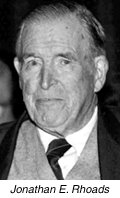Related Topics
Philadelphia Medicine
The first hospital, the first medical school, the first medical society, and abundant Civil War casualties, all combined to establish the most important medical center in the country. It's still the second largest industry in the city.
Philadelphia Physicians
Philadelphia dominated the medical profession so long that it's hard to distinguish between local traditions and national ones. The distinctive feature is that in Philadelphia you must be a real doctor before you become a mere specialist.
Discipline for the Disciple

|
I.S.Ravdin was President Eisenhower's surgeon; Chick Koop was President Reagan's Surgeon General. Both of them were overshadowed by Jonathan Rhoads. Even in a physical sense, this was true. Rhoads was a foot taller than almost anyone. Big bones, too.
During the Second World War, Ravdin led almost every doctor in the University of Pennsylvania off to some military hospital unit or other, and in fact, the 900-bed hospital in Philadelphia was left with only two surgeons, Koop and Rhoads, ineligible for military service because of previous tuberculosis. Koop was a first-year resident in training, so for practical purposes, Rhoads was the only surgeon. Even after eliminating purely elective or optional surgery, the workload was staggering, and the number of operations was prodigious.
Rhoads devised a system. The young trainee, Koop, would do the time-consuming work of opening the belly wall and Rhoads would then do the internal surgery, following which Koop would close the wound while Rhoads was operating on another patient. As Koop told the story at Rhoads' 90th birthday celebration, one day a patient was to have his gall bladder removed. Rhoads told him to open the wound, first, the skin, then the fascial layer, then the peritoneum, while he was finishing up with another patient in another room. At that point, Rhoads felt he would be able to come in and remove the gall bladder. Most gall blabbers are firmly attached to the nearby liver, and must be shaved loose before it is possible to put a clamp around the base to remove them.
On this day, two things were different. Rhoads was delayed in the other room because of some complication, and Koop was just standing around waiting. The other thing that was different was that this particular gall bladder was not attached to the liver at all, but was just flopping around in the belly. When Rhoads continued to be delayed, Koop just went ahead and clipped off the gall bladder; more time elapsed. So he carefully sewed up the peritoneal layer, then the fascial layer, then the skin, stitch by stitch. He was standing there pretty pleased with himself when the doors finally banged open and Rhoads came charging into the operating room.
Koop offered some explanation in a faltering way, but Rhoads did not say a word. A large elbow on a huge arm silently but forcefully brushed Koop off to one side in a single movement. Rhoads then took out each stitch in the skin, then the stitches in the fascia, then the stitches in the peritoneum. He peered into the cavity, inspected the former bed of the gall bladder. Finding things in good order, he then resutured the peritoneum, then the fascia, then the skin. Without a word, he then strode from the room, leaving the future Surgeon General never to forget the lesson he had been taught.
Originally published: Friday, June 23, 2006; most-recently modified: Thursday, May 16, 2019